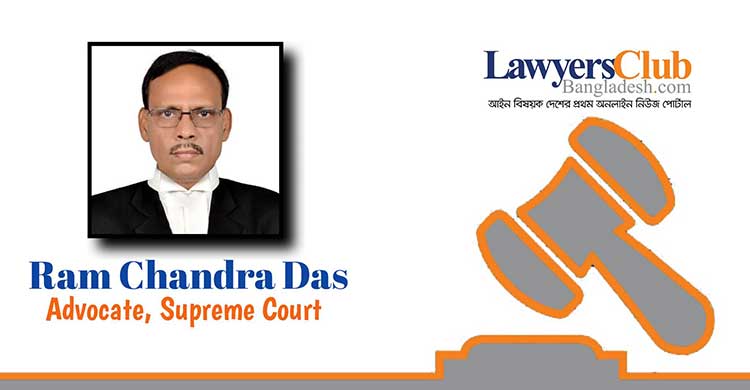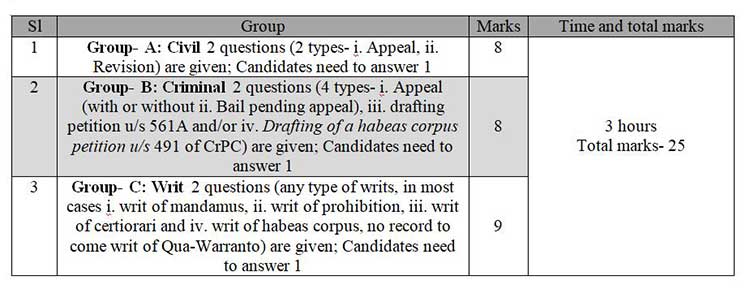Understanding Syllabus of High Court Permission Examination

Ram Chandra Das : Being a candidate, you need to understand the syllabus for taking proper preparation of the Examination. Rule 65A of the of the Bangladesh Legal Practitioners and Bar Council Rules, I972 describes the syllabus of mainly different kinds of memorandum of appeals and petitions from civil, criminal and writ jurisdictions. Besides, the standards of mark-distribution in 5 criteria are also given. This article introduces the syllabus, question types (of drafting petitions) and recent pattern of written questions and most importantly the ‘standards’ of drafting the petitions through which Examiner scores the answer-scripts.
Syllabus as per Rule 65A of the Bangladesh Legal Practitioners and Bar Council Rules, I972
Rule 65A(3) provides as-Where the Board determines to conduct written test the syllabus for the same shall be as decided by the board which may among others include the following-
- Drafting of a Memo of Appeal against Judgement (Civil and Criminal)
- Drafting of a habeas corpus petition
- Drafting of a petition u/s 561A, CrPC
- Drafting of a Civil Revision u/s 115 CPC
- Drafting of a writ petition
Every question shall carry 25 marks or such other marks and distribution thereof shall be as decided by the Board. In deciding distribution of marks following standard may be followed as a guide line as far as possible.
- For format- 5 marks
- For arrangement of facts- 5 marks
- For formulation of prayer- 5 marks
- For language and style 5 marks
- For application of law and framing of grounds-5 narks
(4) Qualifying marks for the written test shall be 12 out of 25 and for oral test shall be 12 out of 25; but the aggregate marks of the two tests must be at least 25 (I,e, 12+13). If an Advocate after qualifying the written test does not appear in the oral test or having appeared failed to pass the oral test he/she may be allowed to appear for the next test only without having to sit for written test, on payment of specified fees as may be decided from time to time, failing which the result of his/her written test shall be treated as cancelled.
Written test questions (‘problem question’), the distribution of marks and time

Type of Question
‘Problem Question’: A ‘problem question’ contains a set of hypothetical facts, in other words, a short case story that asks mainly for drafting along with some related questions. The related questions are to suggest/ advise the client about his/her next course of actions, grounds or legal reasons for maintainability etc.
Trend of Question
Over the period of time, the question pattern has been changed a lot. New trends of High Court Permission Exam Question which are as follows-
- No repetition of previous years’ questions; new case plot (facts of the case) in most cases.
- Application of new laws (for example Stabor Sompotti Adhigrohon O Hukum Dokhol Ain 2017)
- New type of Writ Petition in 2023 (such as Public Interest Litigation, Challenging the order of Tribunal of Election Commission)
- Complicated, confusing and long text (in 2023); symbolic names of parties (A, B, C etc)
- Asking for separate legal grounds/ reasoning (2021)
- Asking to suggest next course of action or legal remedy to the client;
- Examinees are asked to write as per relevant laws (No direct prescription of drafting by following legal provision).
Standard of marks distribution
This part i.e. the 5 criteria or standards of marking, is very important to understand for you all candidates. These 5 standards give you the clear ideas of marks distribution in the specific area which will be helpful for exam preparation.
- For format (5 marks): The format of ‘drafting’ for High Court Practice and Permission Exam is prescribed in the Supreme Court of Bangladesh (High Court Division) Rules, 1973, other relevant laws and longstanding practice of the High Court. For example,
- Form of application under article 102 of the Constitution is referred in Rule 1, Chapter XIA and ‘Form of Writ Petition’ is annexed at Form No. 1, (Writ), Appendix IV;
- Specification of typing and printing is prescribed at Rule 7, Chapter IV of High Court Rules and mentions that an application needs 2 inches margins, 20 lines in a legal-size paper, divided into paragraphs and numbered consecutively.
In practice, margin of a petition is on top 2.5, bottom 1.25, left. 2.00 and right 1.00 inches and line space is double.
- For arrangement of facts (5 marks): Arrangement of facts or statement of facts are important to present your and your opponent’s case. It is your opportunity to highlight your ‘theory of case’ and to draw the attention of audience especially of Judge. So, include and emphasize all legally significant facts and such facts should be arranged logically and sequentially in simple and concise manner. You should not omit your unfavorable facts.
- For formulation of prayer (5 marks):
- Prayer portion is very important and this part describes the ‘remedy of the petitioner’ or reliefs are sought to the court and this portion should be correct technically (otherwise court cannot give appropriate relief to the petitioner)
- Relieves are 3 types, such as ad-interim, substantive and consequential relief.
- Prayer potion generally includes humble approach, issuance of rule (to show cause) calling upon the opposite parties/ respondents (as to why the impugned judgement and decree should not be set aside/ quash), perusal of records, hearing the parties, cause shown, if any and make the rule absolute, and other relief deem fit and proper, and seeking ad-interim relief (stay, injunction, direction, enlarge bail etc.).
- For language and style (5 marks):The language should be grammatically correct i.e. parts of speech, tense, voice, narration, proper punctuation, correct spelling etc. Drafting should be written in plain English; its clearest expression being found in short sentences of commonly used words. The style should be simple with the most appropriate use of legal terms and phrases that would convey the facts in a precise and simple manner. Active voice should be given priority over the passive voice.
- For application of law and framing of grounds (5 narks):
- Mentioning appropriate provision of law is very critical in High Court (being the appellate and writ court). For example, criminal appeal (against conviction and sentence) application is under section 410 of CrPC.
- The grounds of a petition are the reasons on which the impugned judgement is objected to or attacked i.e. “reasons for granting the petition”. The grounds are mainly related to law, case law and evidence. Some grounds are common and some are case specific. You need to prioritize your strongest points and arrange them in the argument (ground) section; put the strongest ground first and then second strong ground and so on.
- Grounds are generally formulated against illegality in mandatory procedure or substantial law, without lawful authority, committed error of law, misreading and nonreading of evidences, could not prove his/her case, failed to apply judicial mind, violation of natural justice.
- Grounds are numbered in roman consecutively.
Conclusion
From the above discussion, you have understood that this session has tried to uncover the syllabus related issues. Though the drafting is the main issue but the ‘drafting’ requires at least 3 important process and skills viz. (a) analyzing facts (from client or ‘problem question’); (b) researching on laws to apply the relevant laws in the case before your hand; and (c) drafting the petitions and finalizing them. In fact, drafting is one of the most important core skills of advocacy. Considering all these, if you go through the issues carefully and understand them well, it would be helpful for your better preparation.
Author is an Advocate, Supreme Court of Bangladesh, High Court Division. Email: ram.chandra.das@gamil.com

